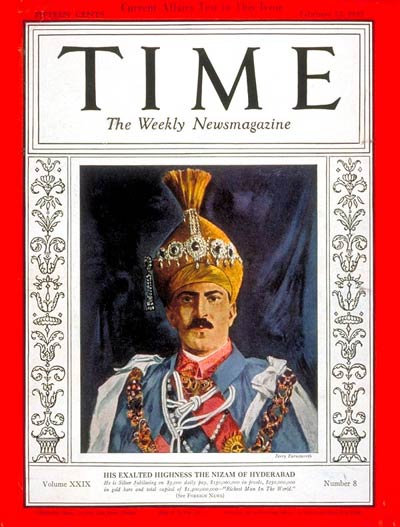As my alma mater began its 100th anniversary celebrations on Wednesday, 26 April, I thought I should pay tribute to the man who founded it.
The founder of India’s prestigious Osmania University, was
an incredible man – amazing and eccentric - who had adorned the cover of TIME
magazine - issue dated 22 February 1937 - in which it called him “the richest man in the world” then.
In fact, the opening lines of TIME’s cover story went like this:
“India has no native state so rich, potent and extensive as Hyderabad which is
about the size of the United Kingdom and there last week the Royal Family of
the Asatia (Asaf Jah) Dynasty celebrated the Silver Jubilee of “The Richest Man
in the World,” Lieut. General His Exalted Highness Sir Mir Osman Ali Khan, the
Nizam of Hyderabad & Berar”.
It continued further, in this way: “Because the scheduled
Coronation Durbar next winter of British King & Emperor George VI has had
to be cancelled by His Majesty (TIME, 15 Feb 1937), there is no immediate
prospect for the world to see such another Indian spectacle of pomp and power
as that of the Jubilee Durbar…”
Such was the pomp and power of the Nizam of Hyderabad then
that the entire world stood aghast, with awe and wonder!
But this seventh and last Nizam of Hyderabad was also a
top-rate miser. An eccentric scrooge.
On the one hand he was so wealthy that he had the Jacob diamond, about the size of a lime, 280 carats, which he used as a paper-weight on his desk. And on the other hand, he was so stingy that he kept wearing the same old fez cap for 35 years!
On the one hand he gave, then, a huge 25 million pound
contribution to the British exchequer during First World War. On the other
hand, he smoked cigarette butts left behind by his guests, saying there
was still a lot of tobacco left in them!
On the one hand, in 1947, as wedding gifts to Princess
Elizabeth (now, Queen Elizabeth II), he had his jewellers ‘Cartier’ present her with a diamond necklace and a tiara. On
the other hand, he used to switch off electricity in his Hyderabad palace to
save on small electricity bills!
In fact, once, when doctors tried to do an ECG (Electro
Cardiogram) test on him, they discovered there was no power in the palace
because he had ordered his palace officials to cut electricity, to save money.
The doctors had a tough time convincing him that electric power was needed for
the ECG machine to work, and for his own good.
Anyway, despite his cheapskate temperament, I am glad he
established a huge University by a Royal Charter in 1917, with his name
‘Osman’.
And just recently, in 2015, this Osmania University was
rated the No.1 State University of India from among 350 such universities, by
India Today-Neilson Survey.
From this university, which turned 100 now, thousands of
graduates, had passed out; including yours truly.
Also recently, in 2001, Osmania was awarded five-star status
by the National Accreditation and Assessment Council (NAAC) by India’s
University Grants Commission.
Surprisingly, though the Nizam was very parsimonious towards
himself, he was very generous towards his subjects.
Osmania Hospital, one of the biggest hospitals in South
India then, was also built by him.
He spent 2 million rupees at the time to build a palatial
structure and threw it open to the public in 1921.
Is it not strange that some of history’s most eccentric
rulers have often given their citizens some of the most amazing developments?


No comments:
Post a Comment